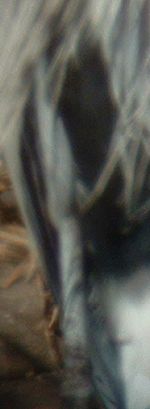This somewhat atypical Great Bue Heron
(Ardea herodias) was photographed in my yard
on Lake Worth, Fort Worth, Texas on December 20, 2002:


Aging this bird is not straightforward (for me, anyway), but it
looks adult-like and should be at least in its second calendar
year, thus not a juvenile or first-winter. It sports a number
of features that are unusual for GBHE of this age, and reminiscent
of Grey Heron (GRHE):
a) The sides of the neck are almost devoid of any warm tones -
just a hint of vinaceousness that is well within range of that
shown by some GRHE.
b) The black lateral crown stripe is very deep - more like that
of GRHE.
c) The pattern of the lores approachs that of some GRHEs, in that
the basal part is cleanly dark gray, while the distal part is
largely yellow (but a bit less extensive than is typical for GRHE.)
d) In the field the thigh feathering appeared to be gray. It was
only while studying my photos that I was able to determine that
the outer feathering of the thighs is gray while the inner feathering
is rufous. Hints of rufous are also visible through the breast
plumes on some photos (not used here), but were not at all visible
in field conditions.
e) The legs are medium gray below the "knee" and pale
gray above the "knee" - this is supposed to be a strong
GRHE feature that should not be seen in GBHEs of this age
Compare the above bird to the non-first-year Grey Heron in these
wonderful
photos by Nigel Blake from late October in the UK. Note also
in Nigel's photos that this GRHE has obvious (with close looks)
rufous elements in the coverts on the bend of the wing - this
has not been mentioned for GRHE of this age in the ID literature
(see below.)
A bird like the above GBHE might lead to a claim of GRHE, if the
rufous elements were further-reduced or not seen in the field
(note that when this GBHE flew, no rufous was seen in the leading
edge of the wing.) The leg proportion seems to offer a helpful
comparison: on the GBHE the tail-tip reaches only about one-third
(or less) below the "knee", while on Nigel's GRHE the
tail-tip is more than half-way below the "knee"; further
checking of this feature may provide a useful long-distance clue
for a potential vagrant (or not!).
ID references:
Gantlett, S.: Identification of Great Blue Heron and Grey Heron;
BIRDING
WORLD Vol 11 No. 1 p12-20.
Clarke, T.: The Great Blue Heron on Tenerife; BIRDING
WORLD Vol 12 No. 4 p158-161.
Lethaby, N. & McLaren, I.: The Identification of Gray Heron;
BIRDING
Vol 34 No. 1 (Feb 2002) p 24-33.


